#duchesses d'auvergne
Text
Marie de Berry

The possibilities for political action were greatest when the mother succeeded in taking over as regent. Marie de Berry was married to Jean I, duke of Bourbon, in 1400. The duke was taken prisoner at the battle of Azincourt, and died in prison in 1434. Marie attempted to negotiate his release and the dauphin provided money for his ransom. However, the duke's acceptance of the treaty of Troyes and of Henry VI in 1429 precluded his return home. Their son was only aged twelve in 1415 and Marie assumed his guardianship and the rule of the duchy in order to try to safeguard its territory. Her husband gave her formal permission to exercise power only in his absence in 1417. Over the years that followed, Marie faced considerable problems arising out of the conflict of Armagnacs and Burgundians. Difficulties also arose over the duchy of Auvergne which her father, John, duke of Berry, in 1386 had declared would revert to the Crown if he died without a male heir, but which Charles VI had agreed at the time could pass to Marie and her husband. On her father's death in 1416 Marie occupied the two main strongholds of the duchy, but she was only allowed to do homage two years later, and it was not until 1425 that Auvergne was handed over by Charles VII at the time of her son's marriage to Agnes of Burgundy. Marie retired from power in 1427 when her husband gave his son the right to administer the duchy.
Jennifer C. Ward- Noblewomen, Family, and Identity in Late Medieval Europe- in Nobles and Nobility in Medieval Europe
#xiv#xv#jennifer c.ward#nobles and nobility in medieval europe#marie de berry#valois princesses#duchesses de bourbon#duchesses d'auvergne#hundred years war#jean i de bourbon#battle of azincourt#jean i de berry#armagnacs vs bourguignons#charles i de bourbon#agnès de bourgogne#charles vii
10 notes
·
View notes
Photo
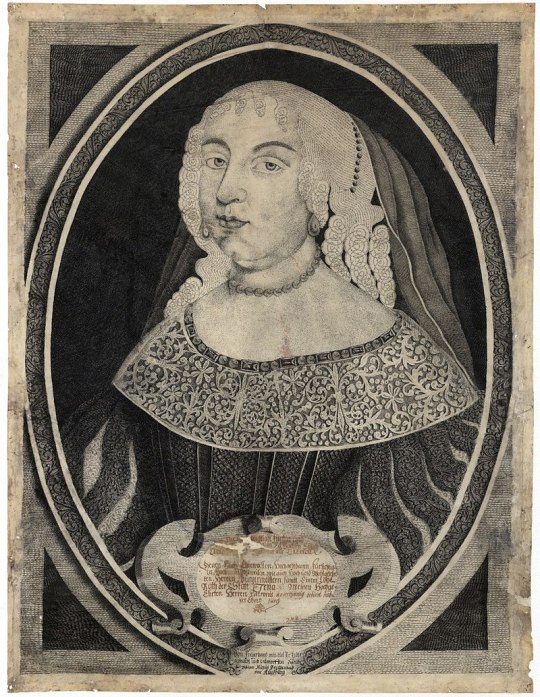
Marie Charlotte de La Trémoille (26 January 1632 – 24 August 1682). was a French noblewoman member of the House of La Trémoille and by marriage Duchess of Saxe-Jena.
Born in Thouars, she was the fifth of six children born from the marriage of Henri III de La Trémoille, 3rd Duke of Thouars, 2nd Duke of La Tremoille, Prince of Talmond and Taranto, and Marie de La Tour d'Auvergne.
#Marie Charlotte de La Trémoille#House La Trémoille#XVII century#people#portrait#Illustration#art#arte
2 notes
·
View notes
Text

Portrait of Mauricette Fébronie de La Tour d'Auvergne, Duchess of Bavaria-Leuchtenberg (1652-1706)
39 notes
·
View notes
Photo

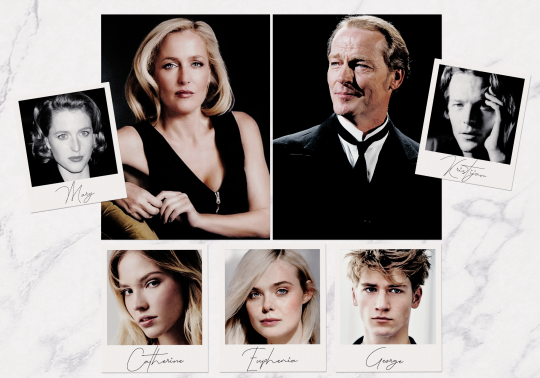

HSHQ TASK eleven —– FAMILY
the royal house of stuart
late king william iv & dowager queen anne
( donald sutherland & julie andrews )
grandpa william came onto the crown at age seven. his father passed away when he was merely five, and his grandfather succumbed from his wounds from the war just a few years later. a joint regency was established by his mother, the dowager princess charlotte, and his uncle: prince thomas. as soon as he reached majority age, he married his childhood sweetheart, lady anne egerton, third daughter to the earl and countess of morton. all things considered anne wasn’t important nor particularly special, but they fell in love, and the king had the luxury to marry whoever he wanted. king william had a lot to prove, which was why he was so deathly strict to all of his children, for they were a chance to prove his legacy. he had to prove that decades of regency would be worth it when he ascended the throne. when he passed, the dowager queen retained some of his trademark stuart rigidness towards her children, but spoiled her grandchildren immensely.
the late king and dowager queen had four children:
queen mary iii of scotland
princess isabel, the duchess of queensberry
prince james of scotland
prince robert, grand duke of greater bavaria
queen mary iii & prince consort christian
( gillian anderson & iain glen )
queen mary did not know the meaning of love. her love language is acts of service, and she truly believes that the best thing she could do for her family and people who were close to her, was to provide them with safety, riches, titles, and the like. conversely, people who did not provide her any service was treated as if they had gave her a personal slight. prince christian of poland was a respectable catholic match, especially for the ever so pious mary, and with one suggestion from the cardinal, she investigated the manner fully. kristijan, the youngest son of king stanisław had the easy confidence that mary was desperately lacking, but with the same sort of innate duty to his country. he’s perfectly content with standing one step behind his wife, to be less important with less responsibilities, he had many hobbies that occupied his time when he wasn’t pushing his nose into his children’s lives.
catherine, euphemia, & george
( sasha luss, elle fanning, danny griffin )
family dynamics task coming soon ig.
princess isabel & lord archibald douglas
duke and duchess of queensberry
( amy adams & ewan mcgregor )
and their children:
lord sebastian douglas, marquess of whithorn ( cameron monaghan )
lady amelia douglas ( annalise basso )
princess isabel is the society darling, president of the debutante board, patron to numerous finishing schools and various social clubs. uncle archie fell in love with her, hard, and did everything he could to win her hand. king william had approved of the marriage just because he would like more family control alongside the ever important southern border. sebastian has the same sort of passion as his father, having married at age twenty-four to his childhood sweetheart ( and debutante of the year ) lady rose murray, daughter of the duke of glasgow, a close family friend. mia, however, was determined to take her time, and make her own way in the world, despite the meddlesome way her mother had moulded her into becoming the next society darling.
prince james & princess eléanor
( simon baker & ashley judd )
and their children:
princess marie-adélaïde ( india eisley )
princess ava ( mackenzie foy )
prince edmund ( samuel joslin )
prince james, the wild-child, had met the utterly beautiful daughter of the duke of aiguillon and prince of turrene, princess eléanor de la tour d'auvergne and decided that all of the girls he dated before her had paled in comparison. she was the very image of french sophistication, and despite his higher rank, her air of lofty superiority had prompted deference even from him. they played the game for a while, chasing each other through the continent and making eyes across glittering ballrooms. that was until eléanor became pregnant unexpectedly with james’ baby, and both sets of parents decided that a marriage was necessary to avoid scandal. the young couple was hastily married, and marie-adélaïde came seven months later. they lived a slightly tumultuous existence, especially since they weren’t ready to get married and settle down in the first place. but with immense therapy and growing determination from both parties, they hadn’t given up yet. eight years after addie then came ava, and a year after that came edmund.
prince robert & lady wiebke wittelsbach
grand duke and duchess of greater bavaria
( kevin mckidd & angela sarafyan )
and their children:
lady anna-amalia wittelsbach of greater bavaria ( lauren de graaf )
lord mathias stuart of greater bavaria ( george mackay )
ya’ll know wibbie. they’re adorable. the stuarts can’t figure out just how robbie the absolute clown had gotten wiebke to take him seriously! a miracle tbh.
4 notes
·
View notes
Photo





The Queen and Duchess French (1/?)
Catherine de’Medici was the only daughter of Lorenzo II de Medici and Madeleine de La Tour d'Auvergne who died shortly after her birth. Clement VII sought a husband for his beloved niece and Francis I of France offered his second son, the Duke of Orleans, Henry as the little girl's husband.
In 1533 the young woman traveled to France and married the prince in the city of Marseilles. Catherine was attracted to her husband, considering him very attractive, but Henry was not attracted or had no interest in the Italian.
While this was happening, Henry VIII of England sought to negotiate a commitment between the dauphin, Francis with his young daughter, Elizabeth Tudor, however the King of France would only accept a marriage with the eldest daughter of the English king, Mary Tudor and that this follow being part of the succession of the throne.
The king had married his mistress Anne Boleyn while he was divorcing his first wife, Catherine of Aragon, and everyone saw his only daughter, Mary, as the true princess of Wales.
In the end, after receiving the threat of the French King to make an alliance with Spain, Henry VIII sent for his daughter who served her sister, Elizabeth, in her castle in Hatfield. Father and daughter met at the castle of Ludlow where the king declared before witnesses the legitimization of his eldest daughter as princess of England and approving with the ambassador of France the marriage of Mary with Francis III of Brittany.
After this event, Mary was returned to her possessions as Princess of Wales and her pension for this same charge (which she would assign to her mother, Catherine of Aragon). Soon after, Mary left for France.
The princess she arrived almost a month later to the town of Fuenterrabía where she was waiting for Francis I, the dolphin and the court. The betrothed were quite pleased and Francis came to say that her betrothed had a very sweet face, while Mary had said that her future husband was very tall and with beautiful eyes.
The couple married two days later in 1536 when Maria was 20 years old and Francis 18, marrying in the duchy of Brittany that belonged to the dolphin.
The new dauphine met her brother-in-law, the other children of King Francis, and her sister-in-law, Catherine de’Medici. At first the two liked each other and even had something in common, but especially in religion, both being fervent Catholics.
That relationship ended up making water when Maria became pregnant shortly after and gave birth in 1537 to her first child, Henry, who would be King of France as Henry II. The birth of the new heir was a great joy in France and various festivals were held in honor of the dolphin.
Catherine de’Medici was frustrated with the birth of the new prince because she could not get pregnant after three years of marriage, which separated her more from her husband and she became very envious of the happy life of the English princess.
La Reina y la Duquesa Francesa (1/?)
Catalina de Medici era la única hija de Lorenzo II de Medici y Madeleine de La Tour d'Auvergne los cuales fallecieron poco después de su nacimiento. Clemente VII busco algún marido para su querida sobrina y Francisco I de Francia ofreció a su segundo hijo, el Duque de Orleans Enrique como marido de la pequeña.
En 1533 la joven viajo a Francia y se caso con el príncipe en la ciudad de Marsellas. Catherine se sintió atraída por su marido considerándolo muy atractivo, pero Enrique no se sentía atraído o no sentía interés por la italiana.
Mientras esto sucedía, Enrique VIII de Inglaterra busco negociar un compromiso entre el delfín, Francisco con su hija pequeña, Isabel Tudor, sin embargo el rey de Francia solo aceptaría un matrimonio con la hija mayor del rey ingles, María Tudor y que esta siguiera siendo parte de la sucesión del trono.
El rey se había casado con su amante Ana Bolena mientras se estaba divorciando de su primera esposa, Catalina de Aragon y todos veían a su única hija, María como la verdadera princesa de Gales.
Al final tras recibir la amenaza del Rey francés de hacer alguna alianza con España, Enrique VIII mando a llamar a su hija que servía a su hermana, Isabel en su castillo en Hatfield. Padre e hija se reunieron en el castillo de Ludlow donde el rey declaro ante testigos la legitimización de su hija mayor como princesa de Inglaterra y aprobando con el embajador de Francia el matrimonio de María con Francisco III de Bretaña.
Tras este acontecimiento a María se les fue devuelta sus posesiones como princesa de Gales y su pensión por este mismo cargo (el cual lo destinaría a su madre, Catalina de Aragon). Poco después María partió hacia Francia.
La princesa llego casi un mes después a la localidad de Fuenterrabía donde la esperaba Francisco I, el delfín y la corte. Los prometidos se agradaron bastante y Francisco llego a decir que su prometida tenia un rostro muy dulce, mientras que María había dicho que su futuro esposo era muy alto y de hermosos ojos.
La pareja se caso dos días después en 1536 cuando María tenia 20 años y Francisco 18, casándose en el ducado de Bretaña que le pertenecía al delfín.
La nueva delfina conoció a sus cuñados los otros hijos del rey Francisco y a su cuñada, Catalina de Medici. En un principio las dos se agradaron e incluso tenían una que otra cosa en común, pero sobre todo en la religión siendo ambas fervientes católicas.
Aquella relación acabo haciendo aguas cuando María se quedo embarazada poco después y alumbro en 1537 a su primer hijo, Enrique que sería Rey de Francia como Enrique II. El nacimiento del nuevo heredero fue una gran alegría en Francia y se celebraron distintas fiestas en honor a la delfina.
Catalina de Medici estaba frustrada con el nacimiento del nuevo príncipe debido a que ella no lograba quedarse embarazada después de tres años de matrimonio lo que la separo mas de su marido y llego a sentir mucha envidia por la vida feliz de la princesa inglesa.
#catherine de medici#mary tudor#francis i of france#henry of valois#francis iii of brittany#henry VIII of england
10 notes
·
View notes
Text
L’Élysée
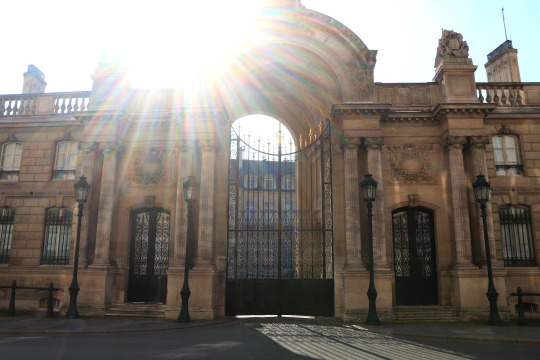
Le 55 rue du Faubourg-Saint-Honoré abrite la Première Maison de France, à savoir la résidence officielle du président de la République française, pour trois ans sous l’éphémère IIème République, puis définitivement depuis 1879, durant la présidence de Patrice de Mac-Mahon, second président de la IIIème République.
Il s'agissait à l'origine d'un hôtel particulier, construit en 1720 par l'architecte Armand-Claude Mollet, pour le compte du Comte d'Evreux, Louis-Henri de La Tour d'Auvergne, sous la Régence de Philippe d'Orléans. Il fut élevé sur un terrain -dit "le marais des Gourdes"- ayant appartenu au célèbre jardinier royal André Le Nôtre, lieu alors champêtre et en dehors de Paris, le long de la perspective nouvellement créée des Champs-Elysées (dont les jardins donneront finalement son appellation au futur Palais). Après le décès du Comte, le roi Louis XV offrit l'hôtel à sa favorite, la Marquise de Pompadour, qui y imposa son style dans sa rénovation et sa nouvelle décoration, pour une somme évaluée à l'époque à près de 100.000 livres! Tour à tour demeure du banquier Nicolas Beaujon, de la duchesse de Bourbon, Bathilde d'Orléans (celle-ci y pratiqua la chiromancie en compagnie du magnétiseur Messmer), puis Café-concert sous la Révolution, l'hôtel est ensuite transformé en Palais par Caroline Bonaparte et son époux, le maréchal d'Empire Joachim Murat (ayant laissé son nom au salon où se tient le conseil des ministres). En son cabinet du salon d'argent, Napoléon Ier prépare sa reddition en 1815. Son futur successeur et neveu, le "Prince-Président" Louis-Napoléon Bonaparte, y fomente son coup d'état en 1852, instaurant le Second Empire et devenant Napoléon III. L'architecte Joseph-Eugène Lacroix transforme alors une partie du Palais, lui donnant sa structure actuelle. Ses occupants républicains suivants ont marqué son histoire : Jules Grévy crée la serre (l'actuel jardin d'hiver); Sadi Carnot fait aménager la monumentale salle des fêtes en 1889; Félix Faure trouve la mort dans la bibliothèque (décédé à la suite d'une fameuse "pompe funèbre"); Vincent Auriol installe 500m2 de cuisines en sous-sol; Charles de Gaulle y demeure à contre-coeur, passant le plus clair de son temps à travailler depuis son bureau du salon doré; l'épouse de Georges Pompidou aménage un salon fumoir (meublé et décoré dans le goût moderne des années 70): Valéry Giscard-d'Estaing instaure le PC Jupiter, situé à 70m sous terre (en l'ancien abri anti-aérien creusé par Albert Lebrun en 1940), afin d'y sertir le système de déclenchement de l'arme nucléaire; François Mitterrand installe dans le vestibule d'honneur la sculpture d'Arman "À la République française"; le salon vert accueille le mariage civil de Gaston Doumergue en 1931 et de Nicolas Sarkozy en 2008...
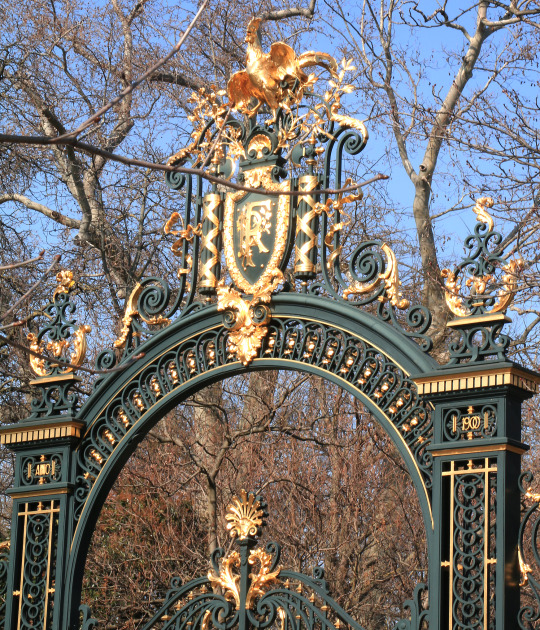
Fleuron du goût artistique évolutif français, les jardins du Palais ne sont pourtant pas "à la française"! Le paysagiste Étienne Louis-Boullée les a redessiné "à l'anglaise" en 1773. Ils abritent trois platanes bi-centennaires. D'une superficie de deux hectares, ils accueillirent chaque année jusqu'en 2010 la célèbre garden-party du 14 juillet. Le président Émile Loubet fait clore en 1900 le parc par la grille du Coq, donnant sur l'avenue Gabriel au Sud, réputée pour accueillir les invités privés du couple présidentiel.
Crédits : ALM's
#monument#élysée#palais#architecture#culture#histoire#jardin#grille#coq#présidence#république#napoléon#murat#hôtel d'évreux#napoléon III#pompadour#présidents#france#paris#prestige#photography#arbres#résidence#salons#garden-party#patriotisme#photoofthenight#like#follow
13 notes
·
View notes
Text
Charlotte d'Albret
Image: the-borgias.fandom.com
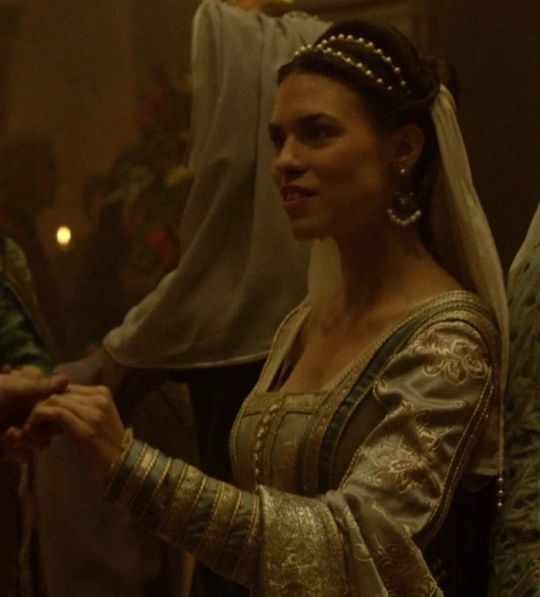
Charlotte d'Albret, Duchess of Valentinois and suo jure dame de Châlus (1480 – March 11, 1514), commonly known as Charlotte d'Albret, was a wealthy French noblewoman of the Albret line, sister of King John III of Navarre, and wife of the famed Cesare Borgia, whom she married in 1499. She was Cesare's sole legitimate daughter, Luisa Borgia, for whom she served as regent following his death.
Charlotte, the daughter of Alan the Great, Lord of Albret, and Francesca de Châtillon-Limoges, was born in 1480. Her paternal grandparents were Count Bertrand V of La Tour d'Auvergne and Boulogne and Isabelle de La Tour d'Auvergne, daughter of Count Bertrand V of La Tour d'Auvergne and Boulogne, and Jacquette du Peschin, and her maternal grandparents were William of Blois, Viscount of Limoges, and Isabelle de La Tour d'Auvergne, daughter of Count Bertrand V of Charles I of Albret, Constable of France, was her paternal great-great-grandfather, and he was killed in command of French troops during the Battle of Agincourt in 1415. He had six siblings, including John of Albret, who married Catherine de Foix and became King of Navarre.
Cesare Borgia's marriage
She married Cesare Borgia, the illegitimate son of Pope Alexander VI and Vannozza Cattanei, in Blois on May 10, 1499, when she was 19 years old. King Louis XII of France recently named him Duke of Valentinois. Cesare's alliance with France was strengthened by the marriage, which was arranged for political reasons. Caesar accompanied King Louis on his invasion of Italy shortly after the wedding.
"Beautiful and wealthy," Carlotta was described. She acquired the estates of Feusines, Néret, and La Motte-Feuilly in 1504.
Cesare and Carlota only had one kid together (despite the fact that Cesare had at least eleven illegitimate children from other mistresses):
Louise Borgia, suo jure lady of Châlus and duchess of Valentinois (May 17, 1500 - 1553), married Louis II de la Trémoille, governor of Burgundy, on April 7, 1517; she married a second time on February 3, 1530, to Philip of Bourbon, lord of Busset, with whom she had children.
César perished at the siege of Viana on March 12, 1507, in the service of Carlota's brother, the king of Navarre, with whom he had sought asylum after escaping from jail in Spain.
4 notes
·
View notes
Photo
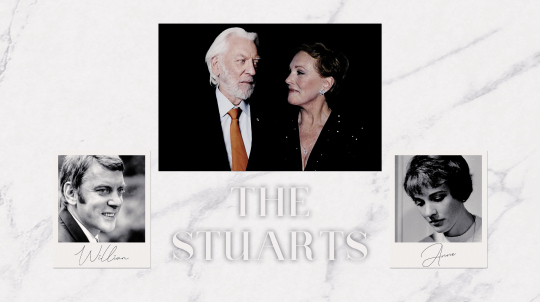


HSHQ TASK eleven —– FAMILY
the royal house of stuart
late king william iv & dowager queen anne
( donald sutherland & julie andrews )
grandpa william came onto the crown at age seven. his father passed away when he was merely five, and his grandfather succumbed from his wounds from the war just a few years later. a joint regency was established by his mother, the dowager princess charlotte, and his uncle: prince thomas. as soon as he reached majority age, he married his childhood sweetheart, lady anne egerton, third daughter to the earl and countess of morton. all things considered anne wasn’t important nor particularly special, but they fell in love, and the king had the luxury to marry whoever he wanted. king william had a lot to prove, which was why he was so deathly strict to all of his children, for they were a chance to prove his legacy. he had to prove that decades of regency would be worth it when he ascended the throne. when he passed, the dowager queen retained some of his trademark stuart rigidness towards her children, but spoiled her grandchildren immensely.
the late king and dowager queen had four children:
queen mary iii of scotland
princess isabel, the duchess of queensberry
prince james of scotland
prince robert, grand duke of greater bavaria
queen mary iii & prince consort christian
( gillian anderson & iain glen )
queen mary did not know the meaning of love. her love language is acts of service, and she truly believes that the best thing she could do for her family and people who were close to her, was to provide them with safety, riches, titles, and the like. conversely, people who did not provide her any service was treated as if they had gave her a personal slight. prince christian of poland was a respectable catholic match, especially for the ever so pious mary, and with one suggestion from the cardinal, she investigated the manner fully. kristijan, the youngest son of king stanisław had the easy confidence that mary was desperately lacking, but with the same sort of innate duty to his country. he’s perfectly content with standing one step behind his wife, to be less important with less responsibilities, he had many hobbies that occupied his time when he wasn’t pushing his nose into his children’s lives.
catherine, euphemia, & george
( sasha luss, elle fanning, danny griffin )
family dynamics task coming soon ig.
princess isabel & lord archibald douglas
duke and duchess of queensberry
( amy adams & ewan mcgregor )
and their children:
lord sebastian douglas, marquess of whithorn ( cameron monaghan )
lady amelia douglas ( annalise basso )
princess isabel is the society darling, president of the debutante board, patron to numerous finishing schools and various social clubs. uncle archie fell in love with her, hard, and did everything he could to win her hand. king william had approved of the marriage just because he would like more family control alongside the ever important southern border. sebastian has the same sort of passion as his father, having married at age twenty-four to his childhood sweetheart ( and debutante of the year ) lady rose murray, daughter of the duke of glasgow, a close family friend. mia, however, was determined to take her time, and make her own way in the world, despite the meddlesome way her mother had moulded her into becoming the next society darling.
prince james & princess eléanor
( simon baker & ashley judd )
and their children:
princess marie-adélaïde ( india eisley )
princess ava ( mackenzie foy )
prince edmund ( samuel joslin )
prince james, the wild-child, had met the utterly beautiful daughter of the duke of aiguillon and prince of turrene, princess eléanor de la tour d'auvergne and decided that all of the girls he dated before her had paled in comparison. she was the very image of french sophistication, and despite his higher rank, her air of lofty superiority had prompted deference even from him. they played the game for a while, chasing each other through the continent and making eyes across glittering ballrooms. that was until eléanor became pregnant unexpectedly with james’ baby, and both sets of parents decided that a marriage was necessary to avoid scandal. the young couple was hastily married, and marie-adélaïde came seven months later. they lived a slightly tumultuous existence, especially since they weren’t ready to get married and settle down in the first place. but with immense therapy and growing determination from both parties, they hadn’t given up yet. eight years after addie then came ava, and a year after that came edmund.
prince robert & lady wiebke wittelsbach
grand duke and duchess of greater bavaria
( kevin mckidd & angela sarafyan )
and their children:
lady anna-amalia wittelsbach of greater bavaria ( lauren de graaf )
lord mathias stuart of greater bavaria ( george mackay )
ya’ll know wibbie. they’re adorable. the stuarts can’t figure out just how robbie the absolute clown had gotten wiebke to take him seriously! a miracle tbh.
11 notes
·
View notes
Text
Contact us here if you wish to play one of them: https://thetudors.forumotion.com/t3179-bavaria

Nikolaus Armand- son to Richard and Natalia a future King of Bavaria. He is a fictional character, his story is all yours to make.
Margot Schuster[/b]- Lady in waiting to Elsa Schroeder, wife to William of Cleves. She is a fictional character, hers story is all yours to make.
Matilda Mayer- lady in waiting to Sybille Cleves, the Duchess of Cleves. She is a fictional character, hers story is all yours to make.
Otto Henry, Elector Palatine- brother to Philip, Duke of Palatinate-Neuburg . As grandson of George of Bavaria, the young Otto Henry became regent of the new duchy of Palatinate-Neuburg after the Palatinate had lost the Landshut War of Succession against Albert IV, Duke of Bavaria. Otto Henry ordered to upgrade the Neuburg Castle, patronised the arts and was involved in several conflicts, due to his expensive holding of court a huge burden of debts caused his bankruptcy until he inherited the Electoral Palatinate in 1556. In the 1550s Otto Henry established the Bibliotheca Palatina.
Felicie Brutz-lady in waiting to Olivia Williams, a fictional character, hers story is all yours to make.
Claude Weber- maid to Amelia Cleves, a fictional character, hers story is all yours to make.
Carlotte D'Aumont- Governess to young Nikolaus Armand, Prince of Bavaria and future King of Bavaria. A fictional character, hers story is all yours to make.
Henry Wilson- dance teacher at Bavaria’s court, a fictional character, his story is all yours to make.
Fritzi Eicher- lady in waiting to Katrina Venderberg, Countess of Schwarzenberg. A fictional character, hers story is all yours to make.
Petra Wagner- lady in waiting to Olga Schroeder, Countess of Schwarzenberg. A fictional character, hers story is all yours to make.
Hannelore Weiss-Hildebrand -Mother to Lorelei Hildebrand.She is a fictional character, her story is all yours to make.
Leopold Hildebrand- father to Lorelei Hildebrand, a fictional character, his story is all yours to make.
Angelika Hildebrand- Half sister to Lorelei Hildebrand
Hugo Hildebrand- Half brother to Lorelei Hildebrand
Charlotte Larsen-lady in waiting to Natalia Grey
Lena Schroeder-is a quiet and pious housewife. She is a mother to Elsa, Olga, and George Schroeder.
Georg von Hardenberg-is a bad tempered, over-domineering, power-hungry noble. Father to Elsa, Olga, and George Schroeder.
Marie of Cleves- cousin to Anne, Amelia Cleves
Enno II- Count of East Frisia was the son of Edzard I of East Frisia. In 1528 he became count of East Frisia. For most of his life he ruled together with Johan I of East Frisia, who remained Catholic, while Enno was Lutheran.
Johann Cirksena- Count of East Frisia was a member of the house of Cirksena and a non-reigning Count of East Frisia and later imperial governor of Limburg. His father, Edzard the Great, had introduced primogeniture in the county of East Frisia, so that his older brother Enno II of East Frisia inherited the county alone and he had to hold back. Despite his ambitions, he always acknowledged his brother's rights and did not dispute the inheritance.
Francis, Grand Duke of Hesse- son to Sofia of Hesse
Maria of Jülich- Berg- Duchess of Cleves and mother to Amelia an Anne of Cleves
Isabel Leigh wife to Philip of Bavaria, and sister to Margaret, Joyce, John, Ralph, Margaret, Mary, Henry, Charles, George, and Catherine Leigh.
Margaretha von Waldeck - Countess of Waldeck
Alice, Grand Duchess of Hesse- daughter to Sofia of Hesse
Margaret of East Frisia- Countess Consort of Waldeck and wife to Philipp IV, Count of Waldeck
Anne of Cleves- sister to Amelia, Sibylle,William
Sarah Brooks- Governess
Maria la Tour d'Auvergne-daughter of Philip, Count of Auvergne and Anne of Hesse,
0 notes
Text
Anne de Beaujeu
Anne de Beaujeu (Anne de France, 1461-1522)
Unofficial regent of France and duchess of Bourbon

Anne de Beaujeu provides an example of female political authority in a country where the Salic Law prevented women from assuming the crown. She also illustrates the tension between an increasingly centralized monarchy on the one hand and feudal independence on the other, having supported both causes at different times in her life. Probably born in 1461, Anne de Beaujeu was the oldest of the surviving children of Louis XI, king of France, and the one said to resemble him most intellectually and temperamentally. When this king died in 1483 leaving a thirteen-year-old Charles VIII on the throne, Anne and her husband, Pierre de Beaujeu, as his guardians, assumed control. In so doing, they resisted Louis d'Orléans, the next in line to the throne, who wished to be named regent. Louis and his supporters sought help from the estates-general who met in 1484 but who ultimately supported Anne's cause. Referred to as Madame la Grande (Grand Madam), Anne was recognized by the court and by foreign emissaries as the person actually ruling France during the early years of Charles's reign.
In 1488 she and Charles VIII squelched a noble uprising, the Guerre Folle (the Foolish War) led by Louis d'Orléans and Francis II duke of Brittany. Charles then married the new duchess of Brittany, Anne, to ensure the duchy's loyalty to France. Meanwhile Pierre de Beaujeu's two older brothers had died, leaving Pierre with the Bourbon inheritance. Anne and her husband were now the richest and most powerful nobles in France. In 1491, after the loss of one infant and fifteen years of childlessness, Anne gave birth to a daughter, Suzanne. As Charles VIII grew increasingly independent of his older sister, Anne redirected her attention to her own lands and feudal duties, though she remained his advisor while retaining her ties to the court. When Charles died suddenly in 1498 leaving no heirs, Louis d'Orléans became king of France. Neither his previous attacks on the crown nor his well-known personal vices inspired confidence in his subjects, so the support of Anne de Beaujeu and her husband were instrumental in a smooth accession to the throne. Anne agreed to overlook their antagonistic past and did not hinder the annulment Louis immediately requested from her physically disabled sister, Jeanne. In exchange, Louis XII waived the royal rights to the Bourbon inheritance in the case that Anne and Pierre did not have a male heir. Once all this had been established, the Bourbon's relationship with Louis XII and his new queen, Charles's widow Anne de Bretagne, became quite cordial. Anne de Beaujeu no longer held any direct influence, however, over the governance of the French state.
In 1504 or 1505, after the death of her husband and before she arranged a marriage for her daughter, Anne wrote Suzanne a book of lessons, Les Enseignements d'Anne de France, duchesse de Bourbonnois et d'Auvergne, à sa fille Susanne de Bourbon, modeled on the book that Louis IX had written for his daughter, the one her own father had written for Charles, and the writings of Christine de Pizan. Anne's version contains conventional advice on the appropriate behavior for noblewomen. During her unofficial regency, Anne had overseen the education of many young noblewomen at court, including Louise de Savoie, Marguerite d'Autriche, and Diane de Poitiers. The humble feminine figure that emerges from the Enseignements, however, seems at odds with their independent author. More easily recognizable are the anxieties about life as an older widow distant from court. The Enseignements ends with a tale about a noblewoman who bravely sacrifices her only child for the honor of her family and the interests of the king. Suzanne was, in fact, married shortly thereafter to a cousin to protect the integrity of the Bourbon inheritance.
In contrast to the moral of her tale, however, the interests of a noble family and those of the crown did not always overlap. Before she died, Anne witnessed the opposition of two adults whom she had raised from childhood: her son-in-law, the connétable de Bourbon, and Louise de Savoie, mother of Francis I, successor to Louis XII. Louise and her son, suspicious of the wealth and power of the connétable, the Bourbon heir, challenged his inheritance. After losing the domain that Anne had so carefully built up and defended during her lifetime, the connétable, perhaps with Anne's bitter approval, responded by betraying the French king Francis I- the other cause that Anne had defended so staunchly during her brother's reign. Anne died in 1522, before this ultimate betrayal.
Emily Thompson in Encyclopedia of Women in the Renaissance.
#xv#xvi#anne de france#anne de beaujeu#regents#duchesse de bourbon#louis xi#charles viii#pierre de beaujeu#louis xii#françois ii de bretagne#anne de bretagne#la guerre folle#suzanne de bourbon#sainte jeanne de france#louise de savoie#marguerite d'autriche#diane de poitiers#charles iii de bourbon#le connétable de bourbon#françois i#proof that anne approved of this ? i didn't find anything#the connétable's betrayal is a complex story#one can point fingers at françois i and louise de savoie too#emily thompson#encyclopedia of women in the renaissance
17 notes
·
View notes
Photo
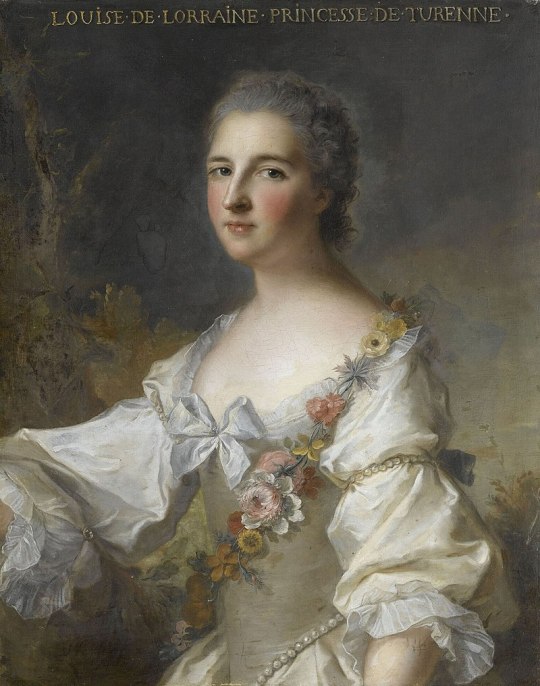
Louise de Lorraine, princesse de Turenne - Jean-Marc Nattier
Louise Henriette Gabrielle of Lorraine (30 December 1718 – 5 September 1788) was a French noblewoman and member of the House of Lorraine. She married into the House of La Tour d'Auvergne and was Duchess of Bouillon.
#Louise of Lorraine#House Lorraine#XVIII century#Jean-Marc Nattier#people#portrait#paintings#art#arte
1 note
·
View note
Note
a sword or a pen is drawn by MARIE LOUISE de LA TOUR D'AUVERGNE, the Duchess of Bouillon. they are thirty one years old and resemble LÉA SEYDOUX. their name draws whispers of being quite passionate & bright, though too often self-serving & wicked. they would rather die than see monarchy thrive without punishment. — {margot, 20, gmt, she/her}
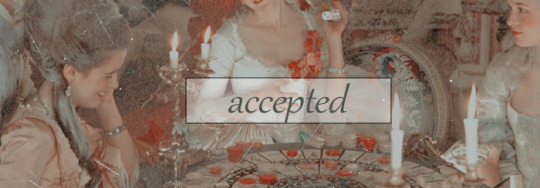
welcome to court, MARIE-LOUISE DE LA TOUR D’AUVERGNE, DUCHESS OF BOUILLON ! history could not be written without you. please send in your account in 24 hours or ask for an extension.
0 notes
Text
youtube
Watch the 2024 American Climate Leadership Awards for High School Students now: https://youtu.be/5C-bb9PoRLc
The recording is now available on ecoAmerica's YouTube channel for viewers to be inspired by student climate leaders! Join Aishah-Nyeta Brown & Jerome Foster II and be inspired by student climate leaders as we recognize the High School Student finalists. Watch now to find out which student received the $25,000 grand prize and top recognition!
#ACLA24#ACLA24HighSchoolStudents#youtube#youtube video#climate leaders#climate solutions#climate action#climate and environment#climate#climate change#climate and health#climate blog#climate justice#climate news#weather and climate#environmental news#environment#environmental awareness#environment and health#environmental#environmental issues#environmental education#environmental justice#environmental protection#environmental health#high school students#high school#youth#youth of america#school
16K notes
·
View notes
Photo

Charlotte de La Marck, Duchess of Bouillon (5 November 1574 - 15 May 1594)
#charlotte de la marck#duchess of bouillon#daughter of henri robert de la marck#wife of henri de la tour d'auvergne#history#women in history#16th century#art
0 notes
Text
Not Such A Fine Romance: Clementina Walkinshaw and Prince Charles Edward Stuart
by Lauren Gilbert
Clementina Maria Sophia Walkinshaw c. 1760
Prince Charles Edward Stuart, known as Bonnie Prince Charlie, was the very stuff of romance. A gallant prince, eldest son of James III/VIII (the Young Pretender to the throne of England, Scotland and Ireland), known for his charm, and a lost cause... Who could resist such a creature? Surprisingly, there are rather fewer identified mistresses for Prince Charles than one might think. One of this number was Clementina Walkinshaw.
Clementina was born to John Walkinshaw of Barrowfield and his wife Katherine Paterson of Bannockburn, their 10th (and youngest) child, all of whom were daughters. Her full name was Clementina Maria Sophia Walkinshaw. Accounts of her place and date of birth vary, some sources placing it between 1720-1725 in Barrowfield in Scotland, others in Rome, Italy. Her father was a staunch supporter of the Jacobite cause, having supported the Stuarts previously in the 1715 uprising and having helped to bring his affianced wife to James III/VIII in 1719. There are suggestions that the family spent a great deal of time on the continent, that Clementina was named for the spouse of James III/VIII, Clementina Sobieski, possibly even her goddaughter, and that Clementina personally was known to the Stuarts in exile. Although suggestions that Clementina and Prince Charles Edward, born December 31, 1720 in Rome, had been childhood friends seem questionable, it does seem possible that there may have been an acquaintance.
At any rate, they definitely became known to one another in 1745. In January of 1746, he stopped at Bannockburn House apparently after the successful battle of Falkirk. Bannockburn was the home of Clementina's uncle, Sir Hugh Paterson. Clementina was there visiting her uncle and her father may also have been present at this visit. During this time, the prince became ill with a cold and fever, and Clementina was supposedly one of the ladies assigned to nurse him. Much was made in some accounts of her cinnamon possets; there were even suggestions that she may have met him earlier and planned to meet him again in Bannockburn. Whatever prior connections there may (or may not) have been, Clementina and the prince definitely became known to each other at this time. Although David Wemyss, Lord Elcho (once the prince's aide-de-camp, and a member of the council), and some others, stated unequivocally that Clementina became the prince's mistress during this visit, it seems to me to be questionable, given her father's and uncle's status and the indications of Clementina's possible connection to the prince's family.
Prince Charles Edward Stuart, 1720-1788. By Allan Ramsay, c. 1745
At any rate, once the prince left Bannockburn in February of 1746, he did not return, as his road led to disaster at Culloden in April, then five months of running and hiding before finally escaping back to France in September of 1746. Once there, he continued to try to rally support for his cause with little success. When Pope Benedict XIX announced in 1747 that he planned to make Prince Charles Edward's younger brother Henry a cardinal in the Roman Catholic Church, Prince Charles Edward was enraged, especially when he discovered that the move was made with their father's support and approval, as this close familial allegiance to the Pope and Church (on top of his family's known preference for the Catholic Church) would make it virtually impossible to convince the English of his Protestant sympathies, and to make a successful claim to the thrones of England, Scotland and Ireland. He became estranged from his father and brother because of this perceived betrayal.
Sometime during 1747, he became reacquainted with his cousin Marie Louise Henriette de la Tour D'Auvergne, who was then married to Jules Hercule Meriadec de Rohan, prince of Guemene. The Prince of Guemene was away in the French army at this time, and Marie Louise and Prince Charles Edward fell passionately in love. They began a passionate secret affair that was quite difficult to conduct as Marie Louise's mother-in-law tried to keep a close eye on her. It does not seem to have been a particularly happy affair, as Charles Edward subjected her to jealous rages and was known to have abused her. However, she was passionately in love with him. This may have been his first real relationship. The affair began to leak out, causing something of a scandal, and Marie Louise ultimately became pregnant. She was forced to end the affair and resumed sleeping with her husband to try to confuse the paternity of the infant. Enraged that she was sleeping with her husband, Charles refused her repeated attempts to see him alone, even though he continued to engage with the family. He told her that he had another mistress, and some sources indicate that the new mistress was Clementina Walkinshaw. However, in BONNIE PRINCE CHARLIE IN LOVE, this mistress was identified as the Princess de Talmont with whom he spent at least a couple of years travelling after he was expelled from France in December of 1748. Marie Louise had the child in July of 1748, and named him Charles Godefroi Sophie Jules Marie de Rohan. Although it appears that James III/VIII was told that he had a grandson, there is nothing to indicate what Charles may have felt about the child. Sadly the child, who had been recognized as a legitimate de Rohan, died in infancy.
Where was Clementina Walkinshaw during this time? It is hard to say as little appears to be known. Her older sister Catherine Walkinshaw (about 12 years older than Clementina) was in England in the household of the Augusta, Princess of Wales (wife of Frederick, Prince of Wales). (After Culloden, there was an apparently an unsuccessful attempt to get rid of her.) Her family appears to have had a foot in both camps. Charles had made efforts to find a suitable German princess to marry, and had his relationship the Princesse de Talmont into 1750-51, marred as it was by jealousy and rages. He also made a brief clandestine visit to Jacobite supporters in London in September of 1750. Although numerous sources implied or stated that Catherine went with him when he returned to the Continent in 1746, this does not appear to be the case. There is no indication of even a correspondence between them.
Clementina appears to have lived quietly until she left Scotland in 1751 for France with the intention of joining a convent. Charles apparently heard she was in France, and asked for her to be found and brought to him. This is hardly an indication of a long-term, passionate affair on his part. Clementina agreed to join him, which does argue feelings for him on her part. Available data indicates she joined him sometime in 1752. Because of this, Clementina's family cut all ties with her. Although Charles' continental connections were courteous to her, the English and Scottish Jacobites urged him to break with Clementina, as they were convinced she was a spy for the English crown, passing information through her sister Catherine. (A real irony since Catherine had nothing further to do with Clementina once the liaison with Prince Charles Edward was known, just like the rest of the family.)
Charles and Clementina moved to Liege in the summer of 1753, and their daughter Charlotte was born in October of 1753. Prince Charles was by this time moody, bitter about his lost opportunities and increasingly drunk. Most accounts describe his drunken rages. They increasingly quarrelled, and he was known to mistreat her. However, they stayed together and there is an indication that they may have had another child that died in infancy. There were also rumours of a possible marriage between the prince and Clementina, although there is nothing to indicate either Charles or Clementina acknowledged a marriage. However, be that as it may, Prince Charles Edward continued to deteriorate and finally, after years of verbal and physical abuse, Clementina took their daughter and left him in July of 1760. They had lived together for eight years.
Clementina and Charlotte were supported by the prince's father, James III/VIII until his death January 1, 1766, then by his brother the cardinal (albeit at a reduced rate, and he apparently had her sign an affidavit that she had never married Prince Charles Edward which was done in Paris in March of 1767). Charles refused to contribute to the support of Clementina or their child. The prince married in 1772, to the Princess Louise of Stolberg-Gedern. Unfortunately, his personal decline continued and the marriage was unhappy. It ended when he attacked her in November of 1780, causing her to leave him. There were no children of this marriage. After the end of that marriage, he made a will, leaving Charlotte as his heir, written in March of 1783. He also granted her the Scottish title of Duchess of Albany and signed an act of legitimation allowing Charlotte to inherit French properties. Unbeknownst to him (and apparently everyone else), Charlotte had had a long-term affair with Prince Ferdinand de Rohan, Archbishop of Bordeaux and subsequently Cambrai. They had two daughters and a son. She left them to move in with Charles in Florence in 1784, and she cared for him until his death the end of January of 1788. There are indications that she may have persuaded him to help Clementina, and certainly he wrote to Clementina occasionally before he died. Sadly, Charlotte herself died in November 17, 1789.
Charlotte Stuart, Duchess of Albany by Hugh Douglas Hamilton, c. 1785-1786
At some point, Clementina was given the title of Comtesse d'Alberstroff. After Charlotte went to live with Prince Charles Edward, Clementina moved to Paris and then subsequently to Switzerland. Accounts indicate that Charlotte left her estate to her uncle, Cardinal York, with instructions for him to take care of her mother. A pension was generated. However, the payment of the pension is not clear. There are indications that, although Clementina should have been comfortably off, she was actually maintained by irregular payments generated by Thomas Coutts, a banker in London, with whom she maintained a friendly correspondence. Many sources indicate she was actually poor and in difficult circumstances. Clementina died in November of 1802. Most sources indicate she died in Fribourg, Switzerland, although there is also an indication that she may have returned to Paris and died there. There is no indication that she ever had any contact with any member of her family. A sad end to a mistress badly treated in a most unromantic affair.
Sources include:
Douglas, Hugh. BONNIE PRINCE CHARLIE IN LOVE The Private Passions of Prince Charles Edward Stuart. 1995: Alan Sutton Publishing Ltd, United Kingdom; 2016: The History Press, Stroud, England-ebook edition. (Kindle)
Archive.org. A HISTORY OF GLASGOW Vol. III. By George Eyre-Todd. 1934: Jackson-Wylie & Co. Chapter 15 "A Glasgow Jacobite: John Walkinshaw of Barrowfield." P. 121. HERE (An easier to read PDF of this chapter can be found HERE)
GoogleBooks.com. MACMILLAN'S MAGAZINE, Vol. XL May 1879 to October 1879. 1879: Macmillan and Co, London and New York. "Burns Unpublished Common-place Book" by William Jack, Part III, PP. 34-39. HERE
GoogleBooks.com. THE SCOTTISH HISTORICAL REVIEW, Vol. XVII, No. 67, April 1920. "Last Days of Clementina Walkinshaw" by A. Francis, Steuart. PP. 249-251. HERE
HistoryofRoyalWomen.com. "The Real Woman of 'Outlander': Marie Louise de la Tour D'Auvergne" posted May 24, 2017 by Franziska. HERE
Jacobites.net. Jacobite Rebellion of 1745 (I) "Clementina Walkinshaw, 1720-1802" (no date or author shown) HERE
Jacobite.ca. "Charlotte, Duchess of Albany" (no author or post date shown, site maintained by Noel S. McFerran.) HERE
Scotsman.com. "Bonnie Prince Charlie and his Glaswegian Mistress" by Alison Campsie, January 4, 2017. HERE
Clanmacfarlanegenealogy.info. MacFARLANE & FAMILIES GENEALOGY. Maintained by Andrew J. Macfarlane. "Individual Report for Clementine Maria Sophia Walkinshaw, Comtesse d'Alberstroff (1603)." HERE; "Lt-Col. John Walkinshaw of Barrowfield, J.P." HERE; "Katherine (Catherine) Walkinshaw" HERE
Images from Wikimedia Commons: Clementina HERE, Prince Charles Edward Stuart HERE and Charlotte HERE
~~~~~~~
About the author:
Lauren Gilbert, a long-time member of the Jane Austen Society of North America, lives in Florida with her husband. In addition to contributing to the English Historical Fiction Authors blog, she published a novel set in Regency England titled HEYERWOOD: A NOVEL, and is working on a second novel, A RATIONAL ATTACHMENT. You can visit her website http://www.lauren-gilbert.com/ for more information.
Hat Tip To: English Historical Fiction Authors
0 notes
Text
Available Characters in Bavaria
Contact us here or at forum if you wish to play one of them:
Margot Schuster[/b]- Lady in waiting to Elsa Schroeder, wife to William of Cleves. She is a fictional character, hers story is all yours to make.
Matilda Mayer- lady in waiting to Sybille Cleves, the Duchess of Cleves. She is a fictional character, hers story is all yours to make.
Raoul Perci- father to Nicholas Perci
Sybille Cleves- sister to Anne, William and Amelia Cleves.
Otto Henry, Elector Palatine- brother to Philip, Duke of Palatinate-Neuburg . As grandson of George of Bavaria, the young Otto Henry became regent of the new duchy of Palatinate-Neuburg after the Palatinate had lost the Landshut War of Succession against Albert IV, Duke of Bavaria. Otto Henry ordered to upgrade the Neuburg Castle, patronised the arts and was involved in several conflicts, due to his expensive holding of court a huge burden of debts caused his bankruptcy until he inherited the Electoral Palatinate in 1556. In the 1550s Otto Henry established the Bibliotheca Palatina.
Felicie Brutz-lady in waiting to Olivia Williams, a fictional character, hers story is all yours to make.
Claude Weber- maid to Amelia Cleves, a fictional character, hers story is all yours to make.
Carlotte D'Aumont- Governess to young Nikolaus Armand, Prince of Bavaria and future King of Bavaria. A fictional character, hers story is all yours to make.
Henry Wilson- dance teacher at Bavaria’s court, a fictional character, his story is all yours to make.
Fritzi Eicher- lady in waiting to Katrina Venderberg, Countess of Schwarzenberg. A fictional character, hers story is all yours to make.
Petra Wagner- lady in waiting to Olga Schroeder, Countess of Schwarzenberg. A fictional character, hers story is all yours to make.
Hannelore Weiss-Hildebrand -Mother to Lorelei Hildebrand.She is a fictional character, her story is all yours to make.
Leopold Hildebrand- father to Lorelei Hildebrand, a fictional character, his story is all yours to make.
Angelika Hildebrand- Half sister to Lorelei Hildebrand
Hugo Hildebrand- Half brother to Lorelei Hildebrand
Charlotte Larsen-lady in waiting to Natalia Grey
George Schroeder- brother to Elsa, Olga
Lena Schroeder-[/b]is a quiet and pious housewife. She is a mother to Elsa, Olga, and George Schroeder.
Georg von Hardenberg-is a bad tempered, over-domineering, power-hungry noble. Father to Elsa, Olga, and George Schroeder.
Marie of Cleves- cousin to Anne, Amelia Cleves
Enno II- Count of East Frisia was the son of Edzard I of East Frisia. In 1528 he became count of East Frisia. For most of his life he ruled together with Johan I of East Frisia, who remained Catholic, while Enno was Lutheran.
Johann Cirksena- Count of East Frisia was a member of the house of Cirksena and a non-reigning Count of East Frisia and later imperial governor of Limburg. His father, Edzard the Great, had introduced primogeniture in the county of East Frisia, so that his older brother Enno II of East Frisia inherited the county alone and he had to hold back. Despite his ambitions, he always acknowledged his brother's rights and did not dispute the inheritance.
Francis, Grand Duke of Hesse- son to Sofia of Hesse
Maria of Jülich- Berg- Duchess of Cleves and mother to Amelia an Anne of Cleves
Isabel Leigh wife to Philip of Bavaria, and sister to Margaret, Joyce, John, Ralph, Margaret, Mary, Henry, Charles, George, and Catherine Leigh.
Margaretha von Waldeck - Countess of Waldeck
Alice, Grand Duchess of Hesse- daughter to Sofia of Hesse
Margaret of East Frisia- Countess Consort of Waldeck and wife to Philipp IV, Count of Waldeck
Anne of Cleves- sister to Amelia, Sibylle,William
Sarah Brooks- Governess
Maria la Tour d'Auvergne-daughter of Philip, Count of Auvergne and Anne of Hesse,
Maria Perci daughter to Raoul Perci
Philipp V - Count of Waldeck
Rose Dashwood - Duchess of Baden-Wurttemburg
Petia Armand - Duchess of Munster; fictional; her story is yours to make
Beatrice Williams - Duchess of Wurttemburg
Olivia Williams - Duchess of Wurrtemburg
Sybille of Baden - Countess of Lichtenstein
Katrina Venderberg - Countess of Schwarzenberg
Rose Dashwood - Duchess of Baden-Wurttemburg
Sofia of Hesse-Grand Duchess of Hesse
0 notes
Text
youtube
Watch the American Climate Leadership Awards 2024 now: https://youtu.be/bWiW4Rp8vF0?feature=shared
The American Climate Leadership Awards 2024 broadcast recording is now available on ecoAmerica's YouTube channel for viewers to be inspired by active climate leaders. Watch to find out which finalist received the $50,000 grand prize! Hosted by Vanessa Hauc and featuring Bill McKibben and Katharine Hayhoe!
#ACLA24#ACLA24Leaders#youtube#youtube video#climate leaders#climate solutions#climate action#climate and environment#climate#climate change#climate and health#climate blog#climate justice#climate news#weather and climate#environmental news#environment#environmental awareness#environment and health#environmental#environmental issues#environmental justice#environment protection#environmental health#Youtube
15K notes
·
View notes